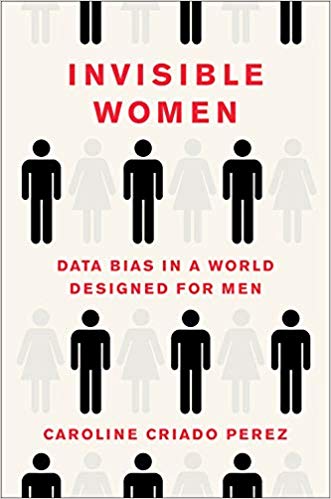
The book, Invisible Women: Data Bias in a World Designed for Men, is one of those books that I’m going to shove toward my unsuspecting friends and say “read this!”, it’s so good. It’s validating for women, will be eye-opening for men, and a vital read for everyone, particularly creators and consumers of data.
Invisible Women takes a critical look at the world where male (often white male) is the default and the harm this does to the female half of the population. It’s a data book because it’s entire thesis centers on data (here gender-disaggregated data), but it’s not a data book where you’ll find data actually analyzed. Rather, author Caroline Criado Perez argues that everything from economic policy to the design of cell phones is biased against women because data is either: not collected on women, not disaggregated by sex, or ignored when female-specific data actually exists. She collectively labels these problems as “the gender data gap.”
This book is incredibly well researched across a huge range of topics. Criado Perez covers everything from transit systems to unpaid labor to car safety design and cites experts, studies, and data (when it actually exists). The chapter on the gender data gap in medicine is particularly staggering. Taken together, her detailed research paints a stark picture of how broadly women are excluded from decision making at all levels.
What I particularly appreciate about Invisible Women is that Criado Perez moves beyond the litany of depressing facts and shows how better data collection and analysis can actually improve women’s lives. Then she cites real world examples of this occurring. By modeling how the experience should be instead of solely focusing on how depressing the situation currently is, Criado Perez demonstrates that designing with women’s needs in mind is both feasible and broadly beneficial to society.
The one deficiency of the book is that I consistently found myself wanting a broader acknowledgement that the gender data gap is compounded by race, disability, etc. Criado Perez cites a couple examples (U.S. maternity mortality in black women and the exclusion of U.S. black women in Hurricane Katrina recovery efforts) but overall falls short in this area. I understand that the book’s focus was on women and that this data gap is likely easiest to identify, since women represent a full half of the human population. That said, the strength of the data-gap argument is missing something essential when we fail to acknowledge that other data gaps exist and intersect with the gender data gap.
Overall, this book is fantastic and a necessary read for those who do any work in the data sphere. For those who aren’t data nerds, Criado Perez’s endless stream of facts is lightened by data success stories and a witty writing style, making this book accessible and enjoyable. I personally enjoyed the audiobook, which is read by the author herself. No matter the format, Invisible Women delivers critical facts on an important topic and is a highly recommended read.




